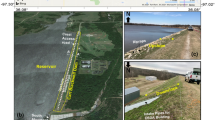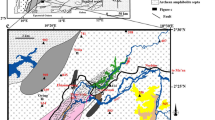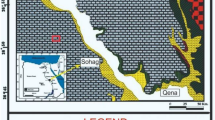Abstract
A case study is reported in this paper, where a combination of seismic refraction and electrical resistivity surveys is used to investigate the cause of excessive water loss in Asa Dam, Nigeria, West Africa. Excessive water loss in the dam has been the reason for the shortage in water supply being experienced by the people of Ilorin, especially in the dry season, in the last 7 years. The study aims to use two geophysical methods to investigate the cause and locate the point of water loss in the dam. Data acquired around the dam foundation were processed to model and image the dam’s subsurface and its surrounding. Electrical resistivity models of the dam’s subsurface revealed a high-permeable water-saturated section in the form of a conductive zone at a horizontal distance of 80–220 m, from near-surface to a depth of about 30 m. The presence of a similar structure on two profile lines perpendicular to the dam confirmed the conductive zone and suggested 3-dimensionality of the conductive structure. Velocity model computed from seismic refraction data acquired along the dam axis revealed the presence of a low-velocity oxbow structure at the mid-section of the dam, between distance 80–200 m from near surface to about 20 m. The presence and correspondence of a low-velocity structure with a high-conductivity structure in the dam’s subsurface, an indication of water-saturated high-permeable rock, was interpreted as the point of excessive water seepage in the dam foundation. The study recommends that the internal geometry of seepage area should be study in greater details using borehole cores and cuttings, in order to design an appropriate anti-seepage rehabilitation intervention.







Similar content being viewed by others
References
Abubakar HO, Raji WO, Bayode S (2014) Direct current resistivity and very low frequency electromagnetic studies for groundwater development in a basement complex area of Nigeria. Sci Focus 19(1):1–10
Aluko KO, Raji WO (2017) Application of 2-D resistivity survey to groundwater aquifer delineation in a sedimentary terrain: a case study of south-western Nigeria. Water Util J 17:71–79
Al-Saigh NH, Mohammed ZS, Dahham MS (1994) Detection of water leakage from dams by self-potential method. Eng Geol 37:115–121
Annor AE, Freeth SJ (1985) Thermo-tectonic evolution of the basement complex around Okene, Nigeria with special reference to the deformation mechanism. Precambrian Res 28:73–77
Annor AE, Olasehinde PI, Pal PC (1987) Basement fracture pattern in the control of river channels. An example from central Nigeria. J Min Geol 26(1):5–11
Asakawa E, Kawanaka T (1993) Seismic ray tracing using linear travel time interpolation. Geophys Prosp 41:99–111
Asfahani J, Radwan Y, Layous I (2010) Integrated geophysical and morphotectonic survey of the impact of Ghab extensional tectonic on the Qastoon Dam, Northwestern Syria. Pure and Appl Geophys 167:323–338
Asfahani J (2018) Geoelectrical combined sounding-profiling configuration for characterizing the sedimentary phosphatic environment in Al-Sharquieh Deposits Mine in Syria. Geofís Int 57(3):189–203
Anderson N, Ismail A (2000) A generalized protocol for selecting appropriate geophysical techniques. Missouri-Rolla University, Dept. of geology and geophysics
Balogun OS, Ganiyu HO (2017) Study and analysis of Asa river hypothetical dam break HEC-RAS. Niger J Technol 36:315–321
Benson RC, Yuhr L, Kaufmann R (2003) Some considerations for the selection and successful application of geophysical methods. Third Int Conf Appl Geophys 8–12, Orlando, Florida
Biswas AK, Charttergee S (1971) Dam disasters - an assessment. Eng J Can 54(3):3–8
Cardarelli E, Cercato M, Donno DG (2018) Surface and borehole geophysics for the rehabilitation of a concrete dam (Penne, Central Italy). Eng Geol 241:1–10
Dan-Hassan MA (2001) Determination of geo-electric sequences and aquifer units in part of the basement complex of north–central Nigeria. Water Res J 12:45–49
Davis SN, DeWiest RJM (1966) Hyrogeology. John Wiley and Sons Inc.
Dobrin MB (1976) Introduction to geophysical prospecting. McGraw-Hill, New York
Fechner TH, Whittaker J, Dietrich P (1996) Seismic tomography for characterization of a hydrogeologic test-site. A Paper Presented at the 2nd EEG Meeting, Nantes France. 2–5 Sept., 58–61
Fargier Y, Palma- Lopes S, Fauchard C, François D, Côte PH (2014) DC-electrical resistivity imaging for embankment dike investigation: a 3D extended normalization approach. J Appl Geophys 103:245–256
Hiltunen DR, Hudyma N, Quigley TP, Samakur C (2007) Ground truthing seismic refraction tomography for sinkhole detection in Florida. Florida. Department of Transport
Hui L, Haitao M (2011) Application of Ground Penetrating Radar in Dam body Investigation. Procedia Engineering 26:1820–1826. https://doi.org/10.1016/j.proeng.2011.11.2372
Jian X, Zhe-jiang Z, Zhao-fa Z (2001) Application of GPR in dam leakage detection. J Changchun Univ Sci Technol 31(1):89–91
Johansson S, Dahlin T (1996) Seepage monitoring in an earth embankment dam repeated resistivity measurements. Eur J Environ Eng Geophys 1:229–247
Karastathis VK, Karmis PN, Drakatos G, Stavrakakis G (2002) Geophysical methods contributing to the testing of concrete dams, application at the Marathon Dam. J Appl Geophys 50:247–260
Karous M, Pernu TK (1985) Combined sounding profiling resistivity measurements with the three-electrode arrays. Geophys Prospect 33:447–459
Loperte A, Soldovieri F, Palombo A, Santini F, Lapenna V (2016) An integrated geophysical approach for water infiltration detection and characterization at Monte Cotugno rock-fill dam (southern Italy). Eng Geol 211:162–170
McMurry P, Wright JB (1977) Geochemistry of calc-alkaline volcanics in northwestern Nigeria, and a possible Pan-African suture zone. Earth Planet Sci Letter 37:90–96
Momayez M, Hassani FP, Guevremont P, Saleh K, Tremblay S (2001) An investigation of the MSR Impact-echo method for concrete dam inspection. Hydro-Review Paper
Nocedal J, Wright SJ (1999) Numerical Optimization. Springer, New York, USA
Oh S (2012) Safety assessment of dams by analysis of the electrical properties of the embankment material. Eng Geol 129:76–90
Okekunle RC (2000) Flood routing along Asa River using kinematic wave and convex routing methods. University of Ilorin, Nigeria, Department of Agricultural Engineering, p 2000
Olasehinde PI, Virbka P, Esan A (1998) preliminary results of hydrogeological investigations in Ilorin area, South Western Nigeria – quality of hydrochemical analysis. Water Res J 9:51–61
Olasehinde PI, Raji WO (2007) Geophysical studies on fractures of basement rocks at University of Ilorin, Southwestern Nigeria: application to groundwater exploration. Water Resour 17:3–10
Osazuwa IB, Chinedu AD (2008) Seismic refraction tomography imaging of high permeability zones beneath an earthen dam, in Zaria area. Nigeria. J Appl Geophys 66(1):44–58
Oyawoye MO (1964) The geology of Nigerian basement complex – a survey of our present knowledge of them. J Min Geol Metal Soc 1(2):87–102
Oyawoye MO (1972) The basement complex of Nigeria. In: Dessauvagie, T.F.J., Whiteman, A.J. (Eds.), African Geology. Ibadan University Press, pp. 66–102
Panthulu TV, Krishnaiah C, Shirke JM (2001) Detection of seepage paths in earth dams using self-potential and electrical resistivity methods. Eng Geol 59(3–4):281–295. https://doi.org/10.1016/S0013-7952(00)00082-X
Pelton JR (2005) Near-surface seismology surface-based methods. In: Butler, D.K. (Ed.), Investigations in geophysics, No. 13: Near-Surface Geophysics. Soc Explor Geophys Tulsa 219–263
Plata A, Iragüen E (1992) Leakage Study at Lake LaLaja Chile. In: Hötzl, Werner (Eds.), Tracer Hydrology. Balkema, pp 378–396
Plata BA, Araguás AL (2002) Detection and prevention of leaks from dams. CRC Press
Rahaman MA (1976) Review of the basement geology of southwestern Nigeria. In: Kogbe CA (ed) Geology of Nigeria, 2nd edn. Elizabethan publication, Lagos, pp 41–58
Raji WO, Aluko KO (2020) Application of seismic and electrical resistivity tomography for locating seepage point in a Composite Dam, north-central Nigeria, expanded abstract, Soc Explor Geophys 2614–2618
Raji WO (2016) Reflection enhancement processing of ultra-shallow reflection surveys. Ilorin J Sci 3(1):11–16
Raji WO, Harris JM, Lu S (2018) Seismic velocity tomography for CO2 monitor in subsurface geological structures. J King Saud Univ Sci 30(1):57–64. http://www.sciencedirect.com/science/article/pii/S1018364716303044
Raji WO, Adeoye TO (2017) Geophysical mapping of contaminant leachate around a reclaimed open dumpsite. J King Saud Univ Sci 29:348–359
Raji WO, Adedoyin DO (2020) Dam safety assessment using 2D electrical resistivity geophysical survey and geological mapping. J King Saud Univ Sci. https://doi.org/10.1016/j.jksus.2019.10.016
Raji WO, Ibrahim OK (2017) Geophysical investigation for Basement Rock Structures around a proposed Dam site. Adamawa State University. J Sci Res 5(2):38–49
Steeples DW, Miller RD (1998) Avoiding pitfalls in shallow seismic reflection surveys. Geophysics 63:1213–1224
Sjödahl P, Dahlin T, Johansson S (2009) Embankment dam seepage evaluation from resistivity monitoring data. Near Surf Geophys 7:463–474
Sjödahl P, Dahlin T, Johansson S (2010) Using the resistivity method for leakage detection in a blind test at the Røssvation embankment dam test facility in Norway. Bul Eng Geol Environ 69:643–658
Sjödahl P, Dahlin T, Johansson S (2005) Using resistivity measurements for dam safety evaluation at Enemossen tailings dam in southern Sweden. Environ Geol 49:267–273
Tikhonov AN, Arsenin VY (1977) Solutions of ill-posed problems: W. H. Winston and Sons
Wang Z (1988) Wave velocities in hydrocarbons and hydrocarbon saturated rock – with application to enhanced oil recovery, Ph.D thesis, Stanford University
Wieland M, Aemmer M, Ruoss R (2008) Design aspects of Deriner dam. Int Water Power Dam Constr 60(7):19–23
Wyllie MRJ, Gregory AR, Gardner LW (1956) Elastic wave velocities in heterogeneous porous media. Geophysics 21:41–70
Zelt CA, Smith RB (1992) Seismic travel time inversion for 2-D crustal velocity structure. Geophys J Int 108:16–34
Acknowledgements
The authors are grateful to the anonymous reviewer and the editor for useful suggestions that improved the quality of the manuscript. The Lower River Niger Basin Authority and persons who participated in field mapping and data acquisition are gratefully acknowledged.
Author information
Authors and Affiliations
Corresponding author
Rights and permissions
About this article
Cite this article
Raji, W.O., Aluko, K.O. Investigating the cause of excessive seepage in a dam foundation using seismic and electrical surveys—a case study of Asa Dam, West Africa. Bull Eng Geol Environ 80, 6445–6455 (2021). https://doi.org/10.1007/s10064-021-02329-9
Received:
Accepted:
Published:
Issue Date:
DOI: https://doi.org/10.1007/s10064-021-02329-9




